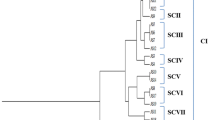Abstract
Pseudomonas is a highly versatile bacterium at the species level with great ecological significance. These genetically and metabolically diverse species have undergone repeated taxonomic revisions. We propose a strategy to identify Pseudomonas up to species level, based on the unique features of their 16S rDNA (rrs) gene sequence, such as the frame work of sequences, sequence motifs and restriction endonuclease (RE) digestion patterns. A species specific phylogenetic framework composed of 31 different rrs sequences, allowed us to segregate 1,367 out of 2,985 rrs sequences of this genus, which have been classified at present only up to genus (Pseudomonas) level, as follows: P. aeruginosa (219 sequences), P. fluorescens (463 sequences), P. putida (347 sequences), P. stutzeri (197 sequences), and P. syringae (141 sequences). These segregations were validated by unique 30–50 nucleotide long motifs and RE digestion patterns in their rrs. A single gene thus provides multiple makers for identification and surveillance of Pseudomonas.





Similar content being viewed by others
References
Jeraldo P, Chia N, Goldenfeld N (2011) On the suitability of short reads of 16S rRNA for phylogeny-based analyses in environmental surveys. Environ Microbiol 13:3000–3009
Kämpfer P, Glaeser SP (2012) Prokaryotic taxonomy in the sequencing era—the polyphasic approach revisited. Environ Microbiol 14:291–317
Hilario E, Buckley TR, Young JM (2004) Improved resolution on the phylogenetic relationships among Pseudomonas by combined analysis of atpD, carA, recA and 16S rDNA. Antonie Van Leeuwenhoek 86:51–64
Mazzaglia A, Studholme DJ, Taratufolo MC, Cai R, Almeida NF, Goodman T, Guttman DS, Vinatzer BA, Balestra GM (2012) Pseudomonas syringae pv. actinidiae (PSA) isolates from recent bacterial canker of Kiwifruit outbreaks belong to the same genetic lineage. PLoS One 7:e36518
Lalucat J, Bennasar A, Bosch R, Garcia-Valdés E, Palleroni NJ (2006) Biology of Pseudomonas stutzeri. Microbiol Mol Biol Rev 70:510–547
Peix A, Ramírez-Bahena MH, Velázquez E (2009) Historical evolution and current status of the taxonomy of genus Pseudomonas. Infect Genet Evol 9:1132–1147
Verma V, Raju SC, Kapley A, Kalia VC, Purohit HJ (2011) Evaluation of genetic and functional diversity of Stenotrophomonas isolates from diverse effluent treatment plants. Bioresour Technol 101:7744–7753
Mulet M, Lalucat J, Garcia-Valdes E (2010) DNA sequence-based analysis of the Pseudomonas species. Environ Microbiol 12:1513–1530
Anzai Y, Kim H, Park JY, Wakabayashi H, Oyaizu H (2000) Phylogenetic affiliation of the pseudomonads based on 16S rRNA sequence. Int J Syst Evol Microbiol 50:1563–1589
Moore ERB, Mau M, Arnscheidt A, Bottger EC, Hutson RA, Collins MD, Van De Peer Y, De Wachter R, Timmis KN (1996) The determination and comparison of the 16S rRNA gene sequences of species of the genus Pseudomonas sensu stricto and estimation of the natural intrageneric relationships. Syst Appl Microbiol 19:478–492
Spiers AJ, Buckling A, Rainey PB (2000) The causes of Pseudomonas diversity. Microbiology 146:2345–2350
Kalia VC, Mukherjee T, Bhushan A, Joshi J, Shankar P, Huma N (2011) Analysis of the unexplored features of rrs (16S rDNA) of the genus Clostridium. BMC Genomics 12:18
Porwal S, Lal S, Cheema S, Kalia VC (2009) Phylogeny in aid of the present and novel microbial lineages: diversity in Bacillus. PLoS One 4:e4438
Lal D, Verma M, Lal R (2011) Exploring internal features of 16S rRNA gene for identification of clinically relevant species of the genus Streptococcus. Ann Clin Microbiol Antimicrob 10:28
Lan Y, Wang Q, Cole JR, Rosen GL (2012) Using the RDP classifier to predict taxonomic novelty and reduce the search space for finding novel organisms. PLoS One 7:e32491
Silby MW, Cerdeño-Tárraga AM, Vernikos GS, Giddens RS, Jackson RW, Preston GM, Zhang X-X, Moon CD, Gehrig SM, Godfrey SAC, Knight CG, Malone JG, Robinson Z, Spiers AJ, Harris S, Challis GL, Yaxley AM, Harris D, Seeger K, Murphy L, Rutter S, Squares R, Quail MA, Saunders E, Mavromatis K, Brettin TS, Bentley D, Shothersall J, Stephens E, Thomas CM, Parkhill J, Levy SB, Rainey PB, Thomson NR (2009) Genomic and genetic analyses of diversity and plant interactions of Pseudomonas fluorescens. Genome Biol 10:R51
Kiil K, Binnewies TT, Willenbrock H, Hansen SK, Yang L, Jelsbak L, Ussery DW, Friis C (2008) Comparative genomics of Pseudomonas. In: Rehm BHA (ed) Pseudomonas: model organism, pathogen, cell factory. Wiley-VCH, Weinheim, pp 1–24
Pirnay JP, De Vos D, Cochez C, Bilocq F, Vanderkelen A, Zizi M, Ghysels B, Cornelis P (2002) Pseudomonas aeruginosa displays an epidemic population structure. Environ Microbiol 4:898–911
Costa R, Salles JF, Berg G, Smalla K (2006) Cultivation-independent analysis of Pseudomonas species in soil and in the rhizoshpere of field-grown Verticillium dahliae host plants. Environ Microbiol 8:2136–2149
Yamamoto S, Kasai H, Arnold DL, Jackson RW, Vivian A, Harayama S (2000) Phylogeny of the genus Pseudomonas: intrageneric structure reconstructed from the nucleotide sequences of gyrB and rpoD genes. Microbiology 146:2385–2394
Morris CE, Sands DC, Vanneste JL, Montarry J, Oakley B, Guibaud Glaux C (2010) Inferring the evolutionary history of the plant pathogen Pseudomonas syringae from its biogeography in headwaters of rivers in North America, Europe, and New Zealand. Mol Biol 1:e00107–e00110
Acknowledgments
This work was supported by the Council of Scientific and Industrial Research, India: CSIR-IGIB and CSIR-NEERI.
Author information
Authors and Affiliations
Corresponding author
Electronic supplementary material
Below is the link to the electronic supplementary material.
Rights and permissions
About this article
Cite this article
Bhushan, A., Joshi, J., Shankar, P. et al. Development of Genomic Tools for the Identification of Certain Pseudomonas up to Species Level. Indian J Microbiol 53, 253–263 (2013). https://doi.org/10.1007/s12088-013-0412-1
Received:
Accepted:
Published:
Issue Date:
DOI: https://doi.org/10.1007/s12088-013-0412-1



